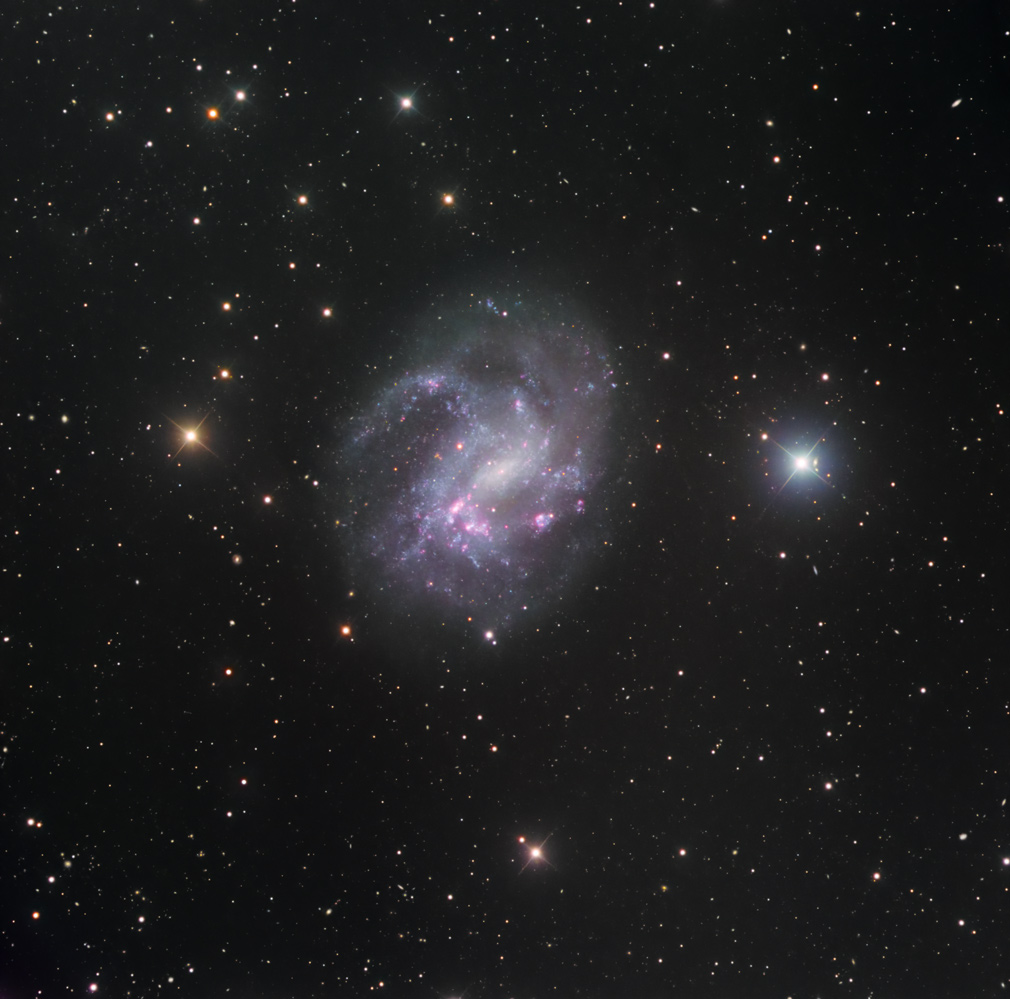NGC 4395 is dwarf spiral galaxy, located quite close to us (in cosmic terms), at about 14 million light
years away. It has a very low surface brightness, making it challenging to image (despite its relative nearness). It is classified as a Seyfert galaxy, and it is
an unsual one in that it has no galactic bulge.
It is interesting to note the amazing advances in the technology available for astronomical imaging in the last 30 years. My photo was taken with a relatively modest (14.5") telescope. Compare my photo above to
this photo taken by the famous 200-inch Hale telescope at Mt. Palomar, in 1993 (at the time, the Hale telescope was the second-largest telescope in the world).
This interesting galaxy has a supermassive black hole at its center, with a mass of "only" about 10,000 times that of our sun, making it a very low-mass supermassive black hole.
It has a diameter of approximately 50,000 light years. The field is about the angular size of a full moon.
|
Technical Information:
Ha:L:R:G:B: 630:1040:300:180:340 (a total of over 41 hours of light-frame exposure time). The luminance layer consisted of a blend of 31 thirty-minute images through the luminance filter, 22 five-minute images through the luminance filter,
and 21 thirty-minute images through the Ha filter. The red channel is a blend of 20 fifteen-minute images thorugh a red filter and the Ha data. The green channel is a combination of 12 fifteen-minute images through the green filter. The blue channel is a combination of 17 twenty-minute images through a blue filter.
Equipment: RC Optical Systems 14.5 inch Ritchey-Chretien carbon fiber truss telescope, with ion-milled optics and RCOS field flattener, at about f/9, and an SBIG STX-16803 camera with
internal filter wheel (SBIG filter set), guided by an SBIG AO-X, all riding on a Bisque Paramount ME German Equatorial Mount.
Image Acquisition/Camera Control: Maxim DL, controlled with ACP Expert/Scheduler, working in concert with TheSky X.
Processing: All images calibrated (darks, bias and sky flats), aligned, combined and cropped in Pixinsight. Color combine in Pixinsight. Some finish work (background neutralization,
color calibration, NB blend, deconvolution, multiscale linear transform, NoiseXTerminator and BlurXTerminator) done in Pixinsight; some cleanup finish work was done in Photoshop CC.
Location: Data acquired remotely from Sierra Remote Observatories, Auberry, California, USA.
Date: Images taken on many nights in January through April of 2023. Image posted October 2, 2023.
Date: Image scale of full-resolution image: 0.56 arcseconds per pixel.
Seeing: Generally good
CCD Chip temperature: -25C

